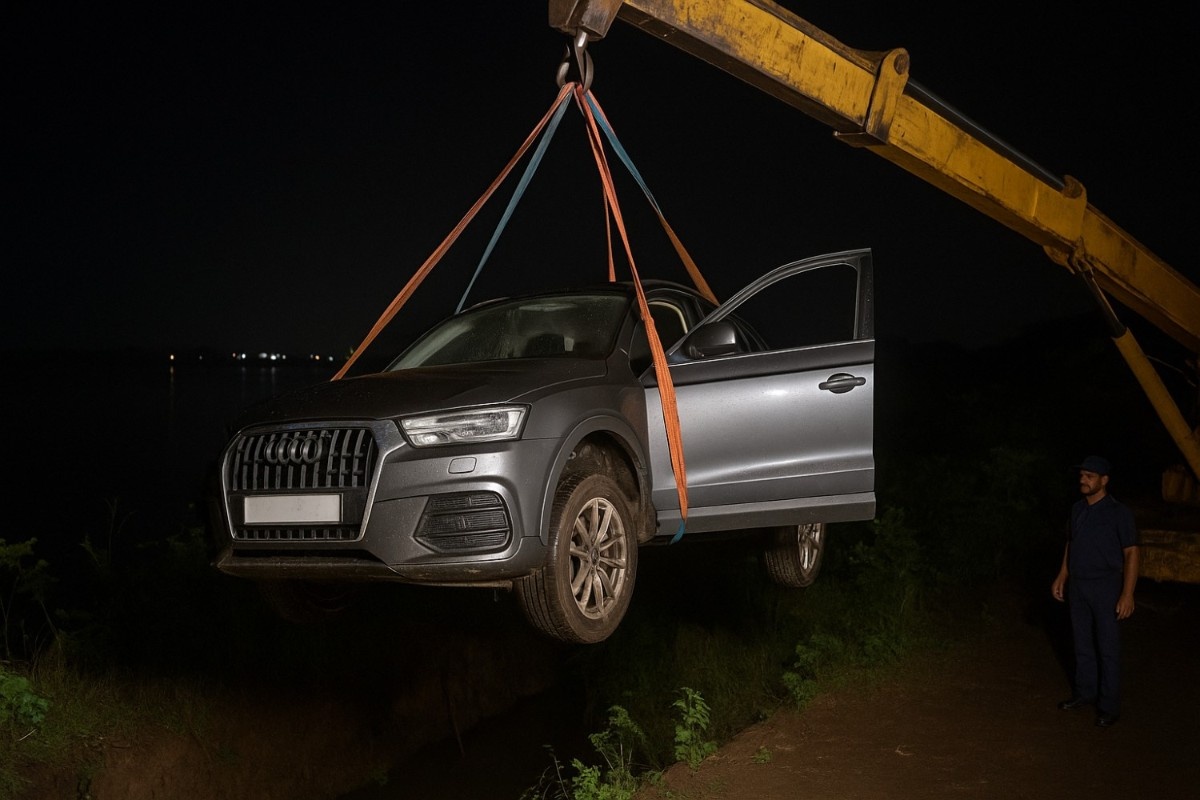Technology is advancing rapidly. People are depending on it more than ever before. Smartphones and apps have become essential for daily navigation. But what happens when technology goes wrong?
In a recent incident in Navi Mumbai, a woman mistakenly drove her Audi Q3 SUV into a 10-foot ditch. The reason? She followed directions given by Google Maps. This accident highlights the potential dangers of over-reliance on digital navigation tools.
Highlights
- Woman’s Audi Q3 fell into a ditch due to faulty Google Maps route.
- Incident occurred in Navi Mumbai at 1 AM on a rainy night.
- Coast Guard Police rescued the woman with a crane and boat.
- The woman survived without serious injuries.
Woman Misguided by Google Maps in Rainy Night
The incident occurred at around 1 AM on a rainy Friday night. The 29-year-old woman was traveling towards Ulwe and was trying to cross the Belapur Bay Bridge. But Google Maps directed her to a service road under the bridge. That road leads toward a restricted jetty area.
The visibility was low due to heavy rainfall. That might have made it harder for the driver to notice roadblocks or signs. Trusting Google Maps fully, she took a left turn unknowingly. That road ended near the Dhruvtara Jetty, a spot that isn’t meant for vehicles.
How the Audi Q3 Fell into the Ditch
According to reports from Coast Guard Police, officers noticed the car approaching the edge of the bay. They signaled her to stop. But before the woman could apply the brakes, her Audi Q3 rolled into the ditch. The car dropped almost 10 feet down.
The driver acted quickly. She managed to open the door before the vehicle submerged. Swimming a short distance, she stayed afloat until the Coast Guard arrived. A marine officer pulled her onto a boat, ensuring her safety.
Coast Guard’s Quick Response Saved Her
Senior Inspector Santosh Kane of the Coast Guard Police gave details of the rescue. The team used a hydraulic crane to pull the Audi Q3 out of the water safely. Thankfully, the woman didn’t suffer any major injuries. She was taken to a nearby hospital for routine checks.
The entire rescue operation went smoothly due to timely intervention. The presence of Coast Guard near the bay turned out to be a lifesaver for the driver.
Google Maps Again Under Fire
This is not the first time Google Maps has been blamed for misguiding users. Over the years, there have been multiple incidents across the globe. From tourists stuck in forests to drivers landing in lakes, the navigation app has had its share of errors.
The common thread in most of these cases is complete reliance on the app without local awareness. While Google Maps is usually accurate, it can’t always identify blocked roads, waterlogged zones, or dead ends in real time.
Why Navigation Errors Still Happen
Google Maps collects data from satellites, users, and road authorities. But in less updated or restricted areas, its data might be outdated or misleading. In this case, the Dhruvtara Jetty road was not meant for regular traffic. Yet, it appeared as a viable route on the map.
Apps like Google Maps also face limitations during bad weather. Rain or fog can interfere with satellite accuracy. That, combined with poor visibility, can create dangerous situations.
Should You Trust Google Maps Completely?
The Navi Mumbai incident serves as a wake-up call. Drivers should use Google Maps with caution, especially in unfamiliar zones. Here are a few safety tips:
- Always check route reviews and ratings on the app.
- If the road seems unsafe or unfamiliar, stop and verify.
- Keep your headlights on in low visibility areas.
- Update the map application regularly for better accuracy.
Technology is a helpful assistant, not a replacement for human judgment. That principle can prevent major accidents caused by apps like Google Maps.
Who is Accountable for Navigation Mistakes?
Many users wonder if they can hold Google Maps legally accountable. But most digital navigation apps include disclaimers. They state that users must take responsibility for following directions.
However, regular complaints and feedback can push companies to improve their systems. Crowdsourced updates, user flags, and AI route predictions are helping reduce such errors over time.
Conclusion: A Lesson in Caution
Luckily, the woman involved in the Navi Mumbai incident walked away unharmed. Her car was damaged, but her life was saved, thanks to the Coast Guard. The core issue lies not in the app alone, but in how much trust users place in it.
Google Maps is a brilliant invention. But even brilliant tools have limitations. The next time you follow a route, take a second to look up, around, and not just down at your phone.
Navigation is a shared job between man and machine. This incident reminds us that blindly following Google Maps can sometimes lead to disaster.
